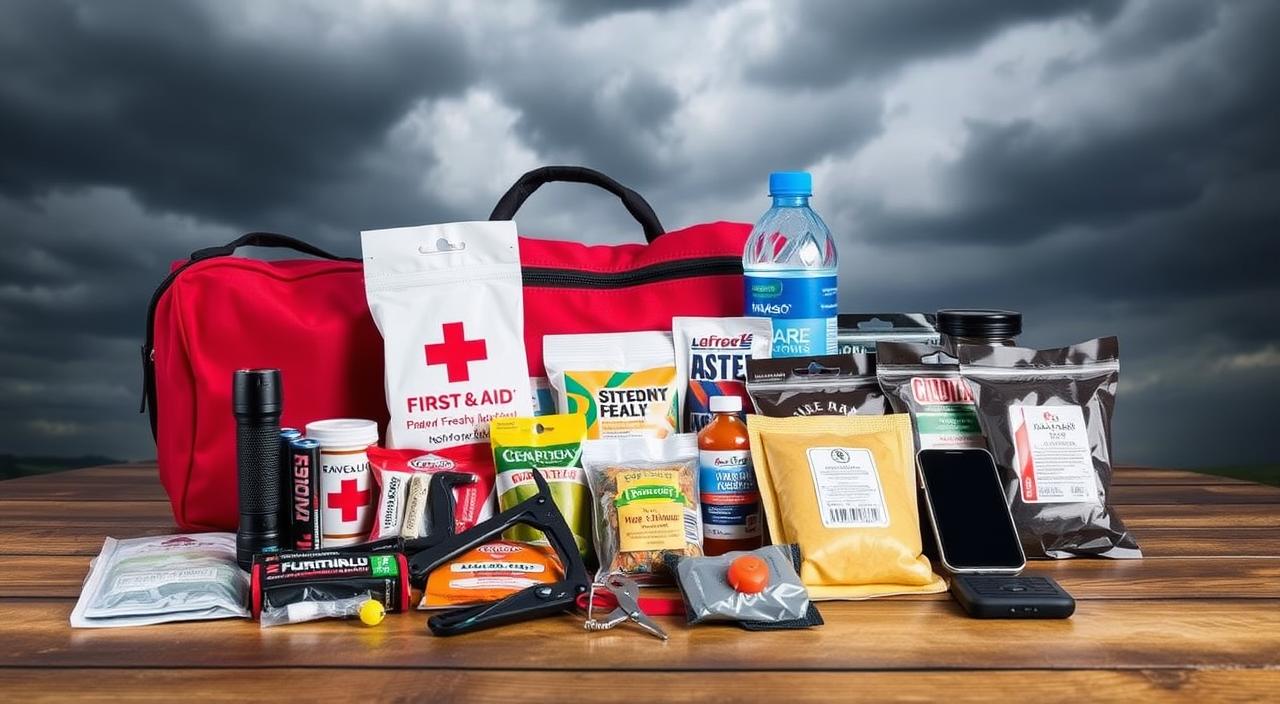Tornado Watch Issued: Stay Safe with These Tips
A tornado watch means the weather might get worse and tornadoes could form. It’s key to stay updated and have a safety plan ready. When a storm warning comes, act fast to keep yourself and your family safe. A weather advisory is a warning to get ready for possible tornadoes.

Being ready for a tornado watch can save lives. Knowing what to do and having a plan can lower the risk of harm or damage. We’ll share more tips on staying safe, like watching the weather and having an emergency kit.
Key Takeaways
- Stay informed about weather conditions during a tornado watch
- Have a plan in place to ensure safety during a severe weather alert
- Understand the difference between a tornado watch and a storm warning
- Prepare an emergency supply kit to help you weather the storm
- Stay tuned for weather updates and follow evacuation instructions if necessary
- Take immediate action to protect yourself and your loved ones during a weather advisory
Understanding What a Tornado Watch Means
A tornado watch means you need to get ready for bad weather. It’s a sign that tornadoes could happen. You should keep an eye on the weather closely.
It’s important to know the difference between a watch and a warning. During a watch, you might see heavy rain, hail, and strong winds. Places in the central and southern Plains are often hit hard by tornadoes.
To stay safe, always check the latest weather news. Watch local news and sign up for emergency alerts. This way, you can protect yourself and your family during a tornado watch.
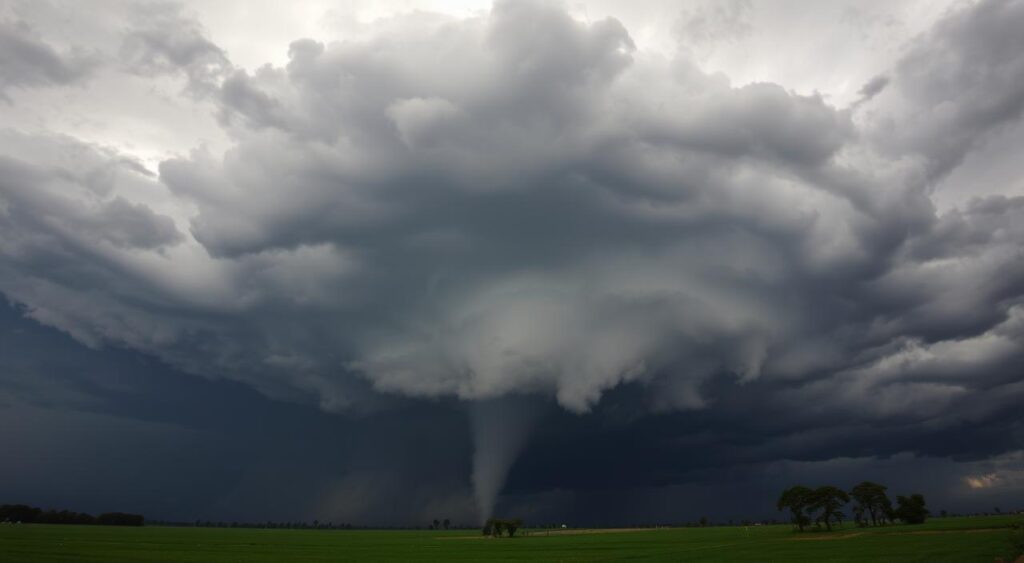
- Stay tuned to local news and weather reports for updates
- Have a plan in place in case a tornado warning is issued
- Know the safest routes to take to get to a safe location
- Keep a battery-powered radio and flashlights on hand in case the power goes out
By following these tips and staying informed, you can keep yourself and your loved ones safe during a tornado watch.
Essential Emergency Supply Kit Components
Having a well-stocked emergency supply kit is key to staying safe during severe weather. It should have water, non-perishable food, first aid supplies, and a battery-powered radio. This helps you stay updated on weather updates and severe weather alerts.
A good emergency kit keeps you and your family safe and comfortable until help arrives. Important items include:
- Flashlights and extra batteries
- Whistle to signal for help if needed
- Dust mask or bandana to help filter the air
- Multipurpose tool, such as a Swiss Army knife
- Local maps, in case GPS is unavailable
Staying informed is also crucial. You can do this by watching wlbt and wapt for the latest weather updates and severe weather alerts. With a well-stocked kit and staying informed, you can keep your family safe during severe weather.
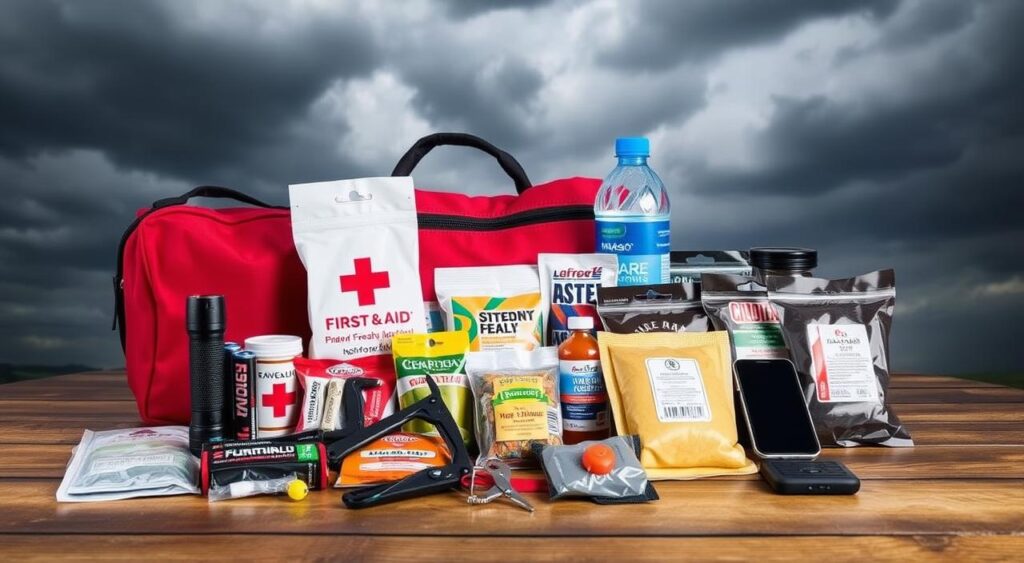
Creating Your Family’s Tornado Safety Plan
A good safety plan is key to keeping your family safe during a tornado. It should include storm tracking and natural disaster alerts to stay informed. This way, you can reduce the risk of injury or damage during a natural disaster.
When making your family’s tornado safety plan, think about these important points:
- Choose a safe room or area, like a basement or storm cellar, for shelter during a tornado.
- Set up emergency communication plans, like a meeting spot outside the home, in case you get separated.
- Practice drills and procedures, like regular tornado drills, to make sure everyone knows what to do.
A good weather warning system is also crucial. By signing up for emergency alerts and watching local news and weather reports, you can stay ahead of the storm. This keeps your family safe.
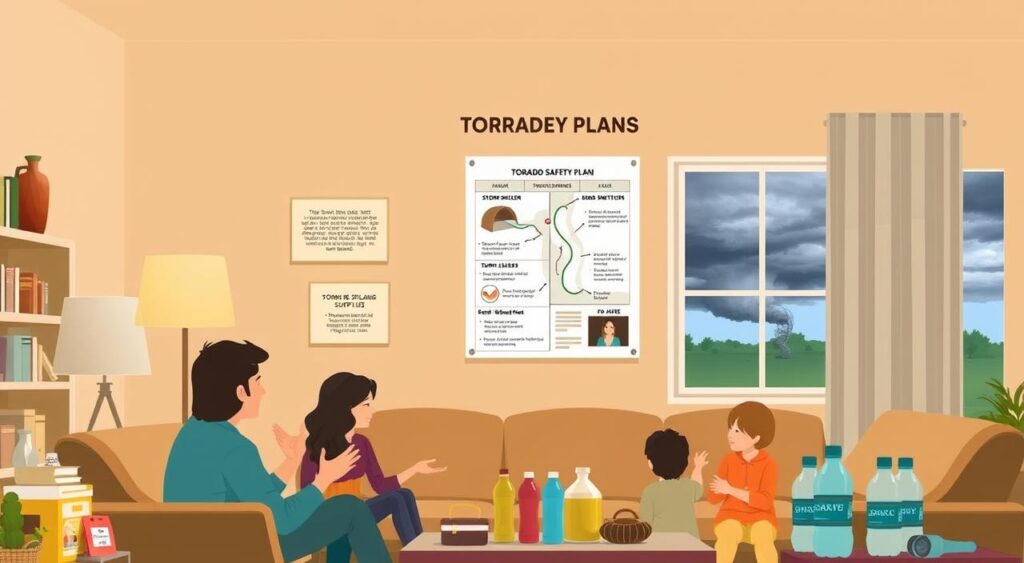
Remember, a well-planned safety plan helps everyone know what to do in a tornado. It also reduces the risk of injury or damage during a natural disaster.
How to Monitor Weather Updates During a Tornado Watch
When a tornado watch is issued, staying informed is key. Severe weather updates can be found on local news and weather apps. It’s important to have a way to get weather forecast updates to keep your family safe.
Weather radar monitoring helps track severe weather. It lets you stay ahead of the storm and take the right safety precautions. Here are some ways to get weather updates:
- Signing up for emergency alerts from your local government or weather service
- Downloading a weather app on your smartphone
- Tuning into local news stations for updates
By staying informed and taking safety precautions, you can protect yourself and your loved ones during a tornado watch. Always put your safety and the safety of those around you first.
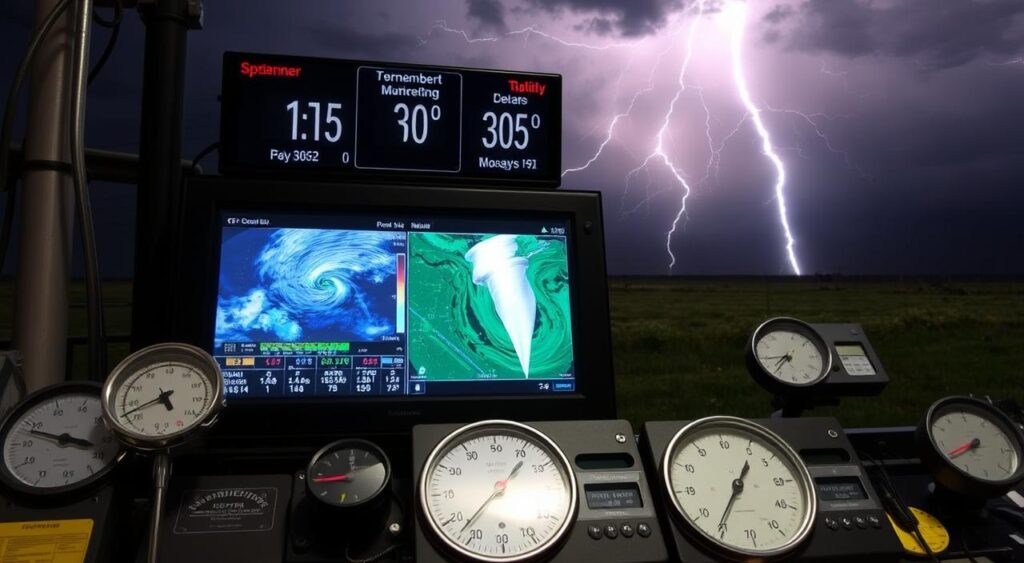
Immediate Steps When a Tornado Watch is Issued
When a severe thunderstorm watch is issued, it’s crucial to act fast to keep you and your family safe. The national weather service gives important updates and safety tips tornado warnings. To stay informed, use a weather radio or a mobile app.
Here are key steps to take when a tornado watch is issued:
- Secure outdoor items, such as patio furniture and trash cans, to prevent them from becoming projectiles in strong winds.
- Prepare your vehicle for safety by filling up the gas tank and making sure you have a spare tire and a first aid kit.
- Take indoor safety measures, such as moving to a basement or storm cellar, or an interior room on the lowest floor of your building.
Having a plan for a tornado warning is also vital. This plan should include a safe place, like a storm shelter or a building with a strong foundation. By taking these steps, you can protect yourself and your loved ones during a tornado watch.
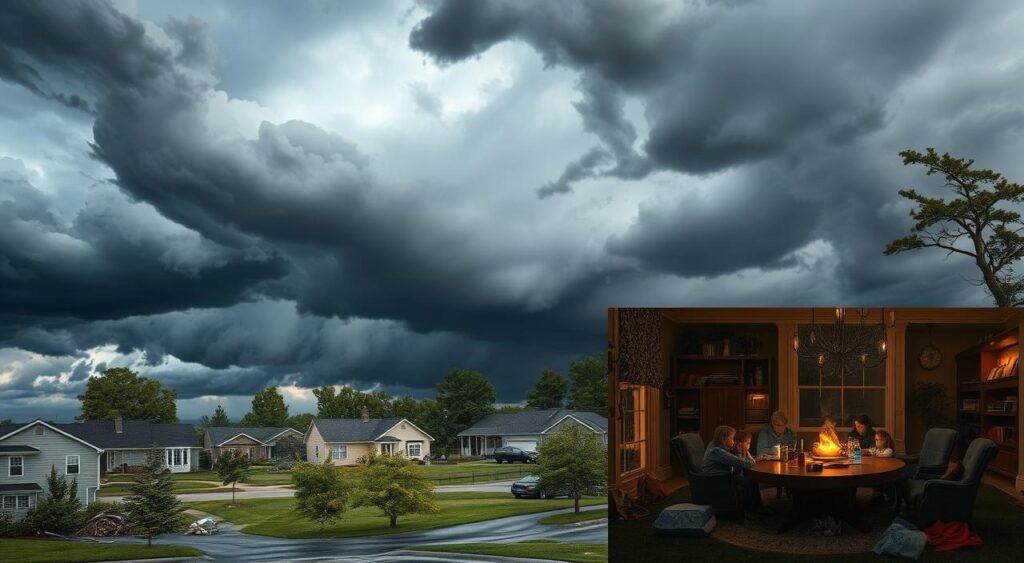
Your safety is the most important thing. By staying informed and taking the right precautions, you can lower the risk of injury or damage from a tornado. Always listen to local authorities and stay tuned to weather updates from the national weather service.
| Safety Measure | Importance |
|---|---|
| Securing outdoor items | High |
| Preparing your vehicle | Medium |
| Taking indoor safety measures | High |
Best Places to Take Shelter
When a tornado warning is issued, it’s crucial to seek shelter immediately. During storm monitoring, it’s essential to stay informed about the tornado season and severe weather conditions in your area. Receiving timely weather alerts can help you and your family stay safe.
Some of the best places to take shelter include basements or storm cellars. These underground areas provide the best protection from high winds and flying debris. If you don’t have access to a basement, consider the following alternatives:
- Interior rooms or closets on the lowest floor of your building
- Bathrooms or closets without windows
- Hallways or corridors on the lowest floor, away from windows and doors
Remember to stay away from windows, doors, and exterior walls, as they can be hazardous during a tornado. By understanding the best places to take shelter and staying informed about severe weather conditions, you can help keep yourself and your loved ones safe during a tornado season. Always prioritize storm monitoring and sign up for weather alerts to stay ahead of the storm.
Technology and Tools for Storm Tracking
It’s vital to stay informed about extreme weather to stay safe. Natural disasters like tornadoes can be very dangerous. Today, we have many tools to track storms and give important safety tips.
For tracking storms, reliable weather apps are key. These apps give you updates on weather, including noaa alerts. Apps like Dark Sky and Weather Underground offer detailed forecasts and alerts for severe weather.
Reliable Weather Apps
- Dark Sky: Provides minute-by-minute forecasts for your location
- Weather Underground: Offers detailed forecasts and severe weather alerts
NOAA weather radio information is also crucial for tracking storms. NOAA weather radios send out alerts and updates during severe weather. This helps you stay safe and informed.
NOAA Weather Radio Information
Local news stations are also great for weather updates. They provide live coverage of weather events. This helps you stay informed and up-to-date.
Using these technologies and tools helps you stay safe during extreme weather. Always follow safety tips and guidelines from weather experts and authorities. This can help prevent injury or damage from natural disasters.
Protecting Your Property During Severe Weather
When a natural disaster alert is issued, it’s crucial to act fast. Thunderstorms and tornadoes can cause a lot of damage. Having a plan, including insurance and documentation, is key.
Before a tornado warning, check your insurance policy. Know what’s covered and what’s not. Also, consider getting a weather radar system for early alerts.
Insurance Considerations
Having the right insurance is vital. Look for policies that cover natural disasters like tornadoes and thunderstorms. Read the policy carefully to understand what’s included.
Documentation Steps
Document your property and belongings before a disaster. Take photos and videos of your home and valuables. Keep records of important documents like insurance policies and receipts. This helps when filing a claim and rebuilding.
By following these steps, you can protect your property from severe weather. Stay updated with weather news and sign up for emergency alerts. Remember, a natural disaster alert is serious, and you must act to keep safe.
Special Considerations for Vulnerable Populations
When it comes to natural disaster readiness, we must focus on the elderly and those with disabilities. They need special care to stay safe during a tornado. It’s crucial to have a solid emergency response plan for them.
Some key things to consider for these groups include:
- Having a support network for evacuation and emergency help
- Ensuring they get real-time alerts and severe weather warnings
- Creating a personal emergency kit with important items like medicine, food, and water
By taking these steps, we can help keep vulnerable populations safe during a tornado. It’s important to stay informed and have a plan ready for emergency response.
Remember, natural disaster readiness is a team effort. Together, we can make our community safer and more resilient for everyone.
| Population | Special Considerations |
|---|---|
| Elderly | Access to medical care, transportation, and social support |
| People with disabilities | Accessible evacuation routes, communication devices, and personal assistance |
Conclusion: Staying Prepared Year-Round for Tornado Watches
Tornado tracking, severe weather updates, and effective disaster response are key to keeping your family safe. By staying informed and ready, you can reduce the dangers of these storms. Check weather forecasts often, keep up with natural disaster updates, and practice your tornado preparedness plan.
Tornado watches are serious. Listen to local authorities, stay alert, and act fast to protect yourself and your family. With the right safety precautions and weather monitoring tools, you can get through the storm safely. Stay safe, stay informed, and stay prepared. Your quick action could save lives when the next tornado watch comes.
FAQ
What is the difference between a tornado watch and a tornado warning?
A tornado watch means weather might create tornadoes. A tornado warning means a tornado has been seen or shown on radar.
What should I include in my emergency supply kit?
Your emergency kit should have water, non-perishable food, first aid, and a battery radio. Also, include other essentials to keep your family safe during bad weather.
How can I create a tornado safety plan for my family?
Choose a safe room in your home. Make a plan for how to communicate in emergencies. Practice drills to get ready for a tornado.
Where should I take shelter during a tornado watch?
The safest place is a basement or storm cellar. If you don’t have one, go to the lowest part of your home. Stay away from windows and doors.
What technology and tools can I use to track severe weather during a tornado watch?
Use weather apps, NOAA weather radio, and local news for updates. This helps you stay informed about the weather and any tornado warnings.
How can I protect my property during a tornado watch?
Check your insurance and document your property. Secure outdoor items and protect your home from damage.
What special considerations should I take for vulnerable populations during a tornado watch?
Make sure the elderly and people with disabilities have emergency plans. They should also get severe weather warnings and updates.
